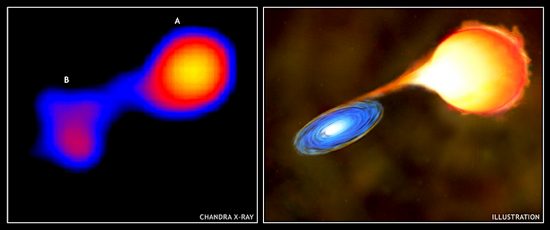Nov 30, 2017
Different kinds of objects have long “tails”.
From galactic-scale objects such as Centaurus A, to hot-bright stars, to planets, to comets, it seems like everything in space exhibits an energetic jet or trailing emission that is difficult to explain using conventional theories. Every new observation requires a new revision, or an admission of complete bafflement.
It is the heart of science to say, “I don’t know” and then proceed from that platform of ignorance into discovery. Consensus astronomers say, “we know that gravity makes the Universe work and that’s it.” Or, “there is no electricity in space and even if there were, it isn’t doing anything.” Problems arise when the things and events they record with their instruments deny such assertions.
Omicron Ceti is a case in point. Otherwise known as Mira, Omicron Ceti is a pair of stars orbiting a common center: a binary star. Mira A is a red giant star and Mira B is thought to be a white dwarf, or perhaps a more normal “main sequence” star. Mira A is a variable star and was the first one discovered that was not the remnant of a supernova explosion. In an electric Universe, double stars (and other multiple star systems) are indicators that excessive electrical charge has resulted in stellar fissioning. The same process can also explain the supernova phenomenon, except on a more dramatic scale.
Astronomers were shocked when X-ray and ultraviolet observations of Mira indicated a long tail extending for thirteen light-years behind what they thought was a well-known star. Naturally, the gravity Universe allows them to consider phenomena such as “jet contrails” or “speed boat wakes” as the only ways that the observation can make sense.
Investigators ignore explanations that involve the most all-pervasive component in the Universe, electrified plasma. Plasma makes up 99% of all that exists. In a plasma tube, electrons can be excited by the current flow into florescence and give off ultraviolet light. However, astrophysicists think the high-frequency emissions are from another source: hot gas in a “bow shock” causing material to swirl around behind the star like the trail of smoke from a train or a steamship.
They also believe something else in addition to fluorescence is causing Mira to shine in ultraviolet light. It is thought that collisions in Mira’s “cool” hydrogen wake with “hot electrons” in the “bow shock” excites atoms into glow-mode with enough intensity to emit high frequency radiation.
Explaining Mira’s energetic ultraviolet tail, or jet of material, as “speedboat wakes” and “smoke”, astronomers miss important clues about what is most likely causing both manifestations: electricity in Birkeland currents transmitted across vast distances in ionized plasmas.
Since wakes, contrails and smoke all spread out as they move away, the tail streaming back from Mira cannot be a mechanically produced phenomenon. Mira’s tail is highly organized along its entire light-years-long length into a twisted helix, indicating that it is probably Birkeland current filaments.
Stephen Smith













